Table of Contents
Introduction
According to Mixed Reality Statistics, Mixed Reality (MR) seamlessly integrates the real world with digital elements, creating environments where physical and digital objects coexist and interact in real-time.
It stands between the fully immersive experiences of Virtual Reality (VR) and the simple digital overlays of Augmented Reality (AR), leveraging technologies such as sensors, advanced computing, and head-mounted displays to foster unique interactions.
MR finds applications in diverse sectors, including education, healthcare, manufacturing, retail, and entertainment, offering immersive learning experiences, aiding in complex surgical procedures, enhancing product design and visualization, improving customer engagement, and creating novel entertainment options.
As MR technology advances, it faces challenges like hardware miniaturization and privacy concerns. Yet, its evolving capabilities continue to shape a future where digital and physical realms merge more seamlessly, transforming everyday experiences.
Editor’s Choice
- The global Mixed Reality (MR) market revenue is expected to reach USD 1,224.0 billion by 2032.
- The Mixed Reality (MR) market demonstrates a diverse application spread, with Automotive & Aerospace leading the way, holding a 27% market share.
- In 2020, among the user base of the augmented and virtual reality (VR) software market, video games led the charge with a substantial user base of 70 million, a figure projected to surge to 215 million by 2025.
- In the realm of virtual reality (VR), the most captivating aspect, as perceived by users, is the feeling of entering another world, with 47% of responses highlighting this immersive reality experience as the pinnacle of VR’s allure.
- As of October 2022, gaming emerged as the most popular application in the U.S., with 37% of respondents indicating their interest, highlighting VR’s significant impact on enhancing the gaming experience.
- The consumer segment leads the investment in AR and VR, with spending reaching USD 6.36 billion, underscoring the significant interest in AR and VR for personal entertainment, gaming, and shopping experiences.
- User experiences, highlighted by issues such as bulky hardware and technical glitches, are a major concern, affecting AR and VR at rates of 32% and 19%, respectively.
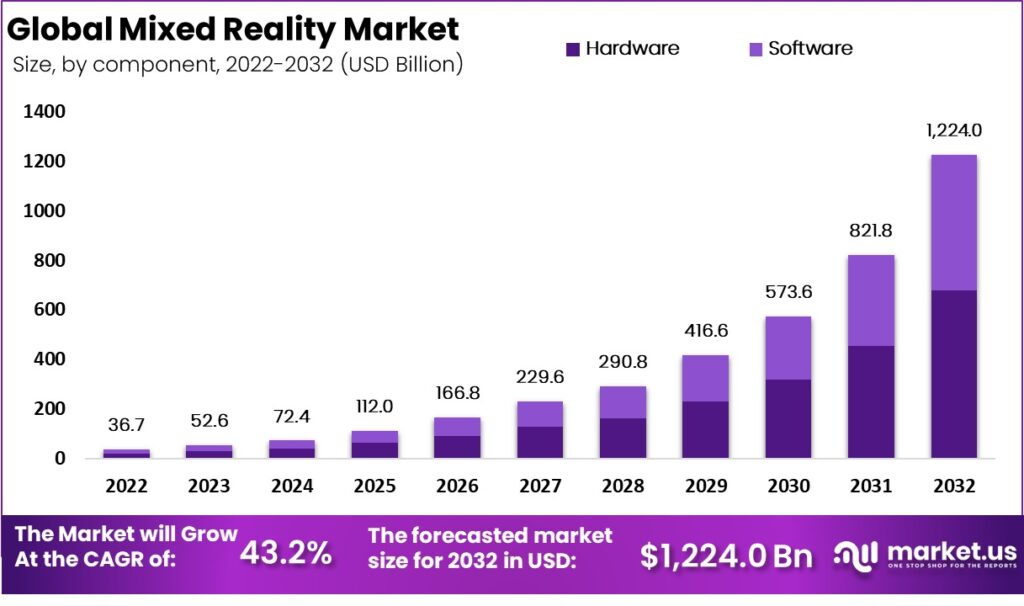
Global Mixed Reality Market Overview
Global Mixed Reality Market Size
- The global Mixed Reality (MR) market has demonstrated remarkable growth over a decade at a CAGR of 43.2%, starting with a revenue of USD 36.7 billion in 2022.
- By 2023, this figure rose significantly to USD 52.6 billion, indicating the accelerating interest and investment in MR technologies.
- The market continued to expand robustly, reaching USD 72.4 billion in 2024.
- By 2030, the market was expected to reach USD 573.6 billion, further escalating to USD 821.8 billion in 2031.
- The growth trajectory culminated in an impressive market revenue of USD 1,224.0 billion by 2032, highlighting the substantial impact and potential of Mixed Reality technology in transforming industries and user experiences worldwide.
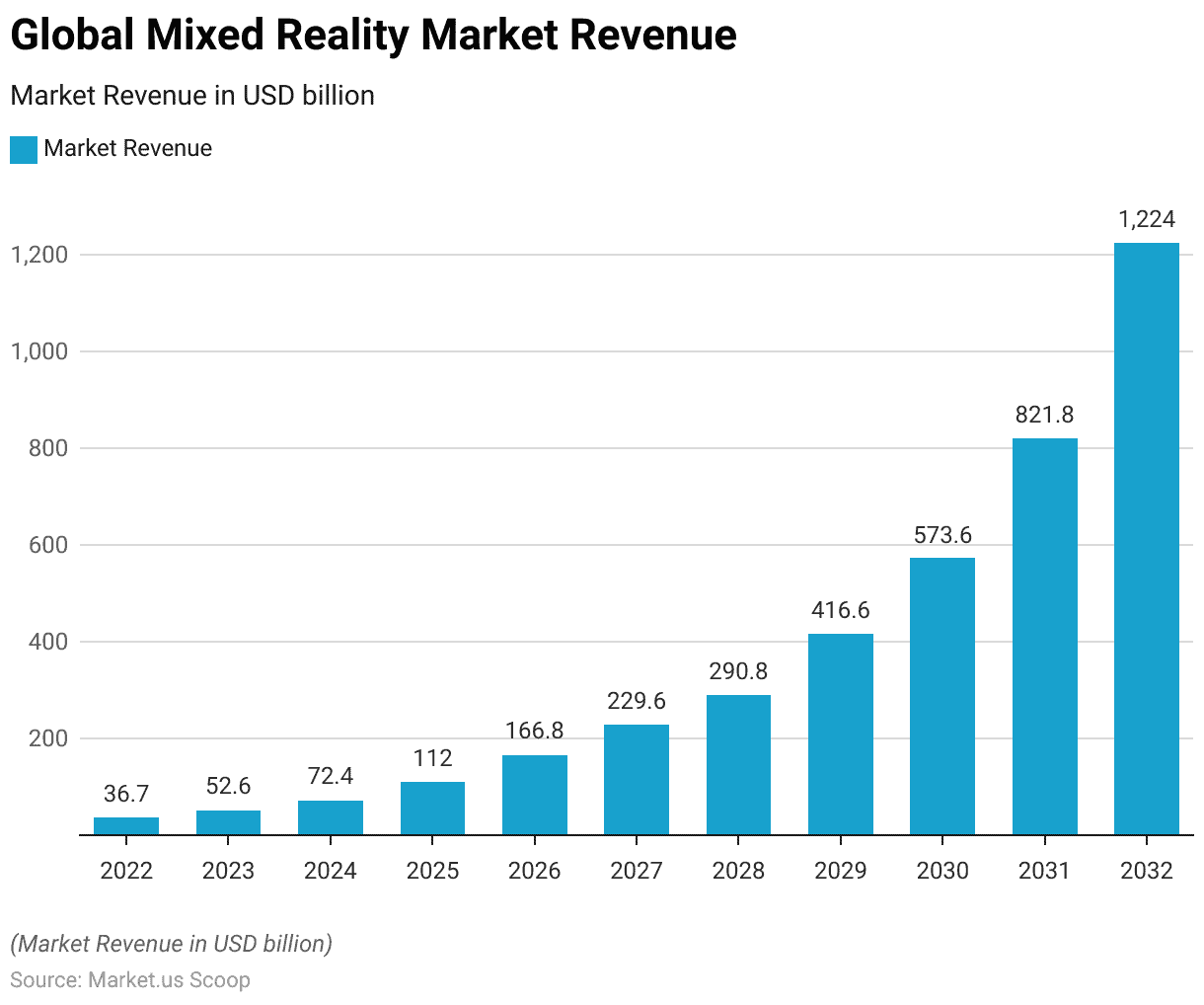
Mixed Reality Market Size – By Component
- The global Mixed Reality (MR) market has seen remarkable growth over the past decade, driven by significant contributions from both hardware and software components.
- Starting in 2022 with a market revenue of USD 36.7 billion, split between USD 28.81 billion from hardware and USD 7.89 billion from software, the market has consistently expanded.
- By 2023, it reached USD 52.6 billion and continued its upward trajectory, reaching USD 72.4 billion in 2024.
- This growth momentum was sustained, with market revenues hitting USD 112.0 billion in 2025 and then leaping to USD 166.8 billion in 2026.
- The trend continued upward, culminating in market sizes of USD 821.8 billion and USD 1,224.0 billion in 2031 and 2032, respectively.
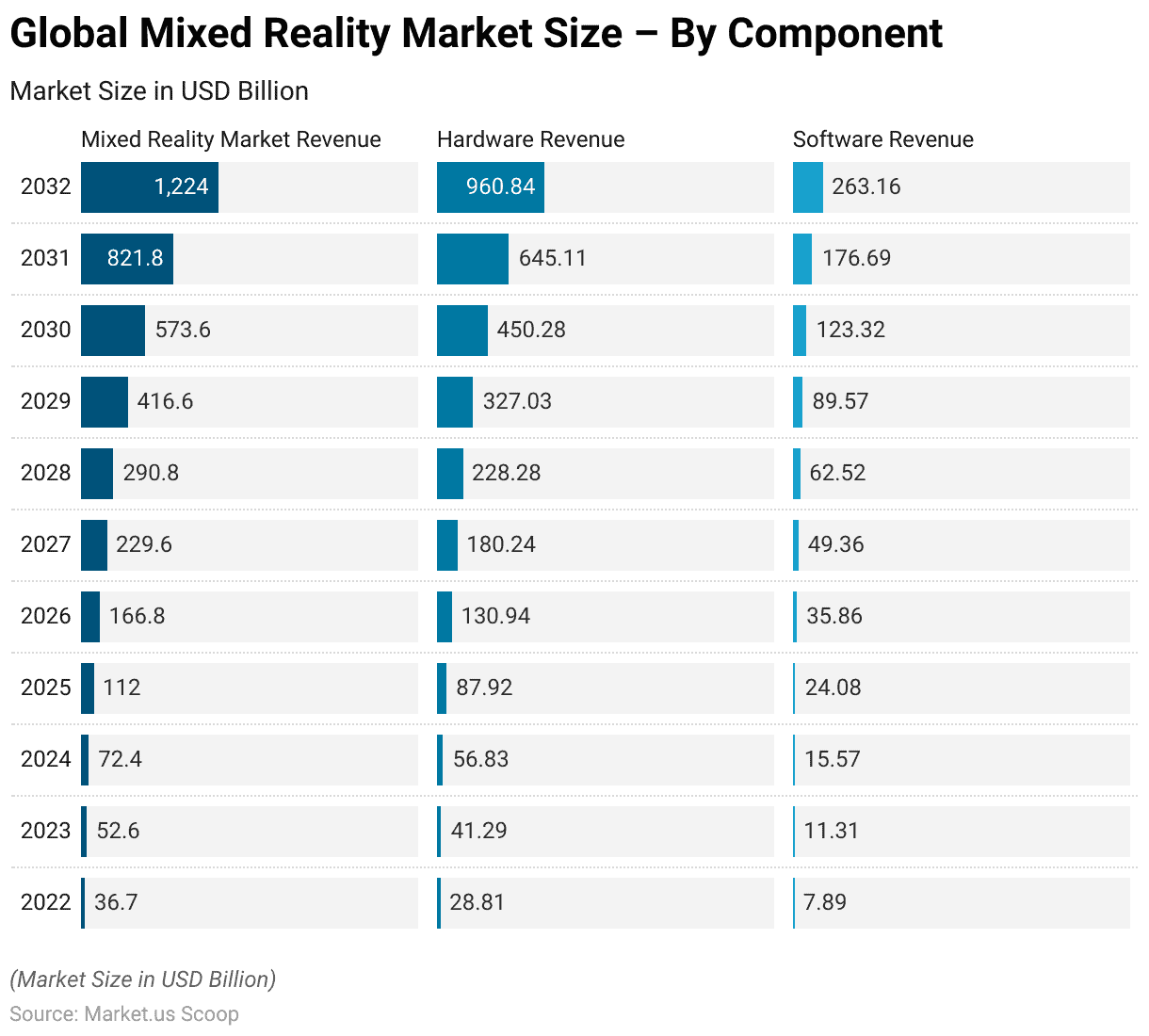
Mixed Reality Market Share – By Application
- The Mixed Reality (MR) market demonstrates a diverse application spread, with Automotive & Aerospace leading the way, holding a 27% market share.
- This is closely followed by the Healthcare sector, which commands a 23% share, highlighting MR’s significant impact on improving diagnostics, patient care, and surgical procedures.
- Entertainment, along with E-commerce & Retail, each contribute 17% to the market, reflecting MR’s role in transforming consumer experiences, from immersive gaming to innovative shopping experiences.
- Other Applications, encompassing sectors such as education, manufacturing, and real estate, account for the remaining 16%, indicating MR’s wide-reaching potential across various industries.
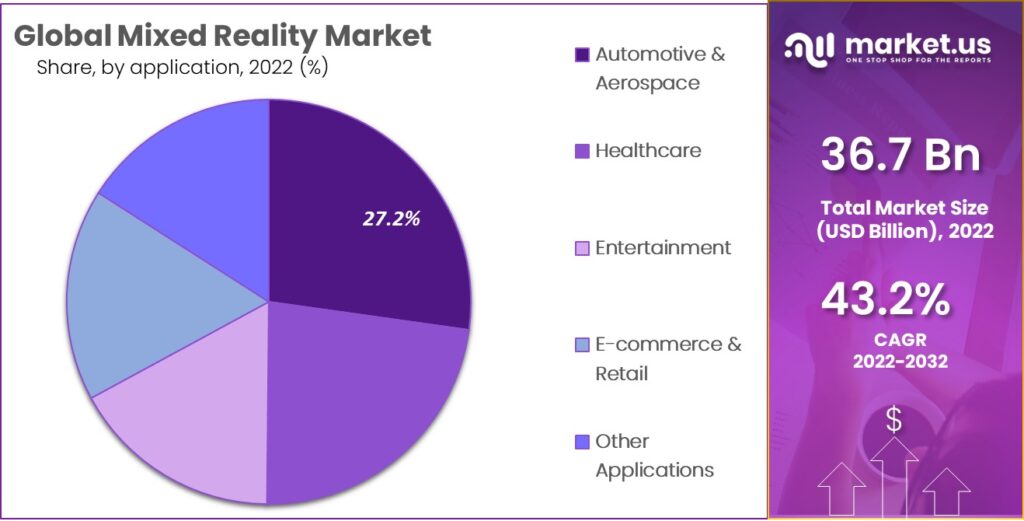
User Base of the Augmented and Virtual Reality (VR) Software Market – By Segment
- In 2020, the user base of the augmented and virtual reality (VR) software market worldwide exhibited a varied distribution across different segments.
- Video games led the charge with a substantial user base of 70 million, a figure projected to surge to 215 million by 2025.
- Live events followed, boasting 28 million users in 2020, with expectations to rise to 95 million in 5 years.
- Video entertainment also showed strong engagement with 24 million users, which is anticipated to grow to 79 million by 2025.
- Retail and education sectors demonstrated promising growth, starting from 9.5 million and 7 million users, respectively, in 2020, and are forecasted to expand to 31.5 million and 15 million users by 2025.
- Healthcare, engineering, and real estate segments, though starting from smaller bases—0.8 million, 1 million, and 0.2 million users, respectively, in 2020—were also expected to witness growth, with healthcare reaching 3.4 million, engineering 3.2 million, and real estate slightly growing to 0.3 million users by 2025.
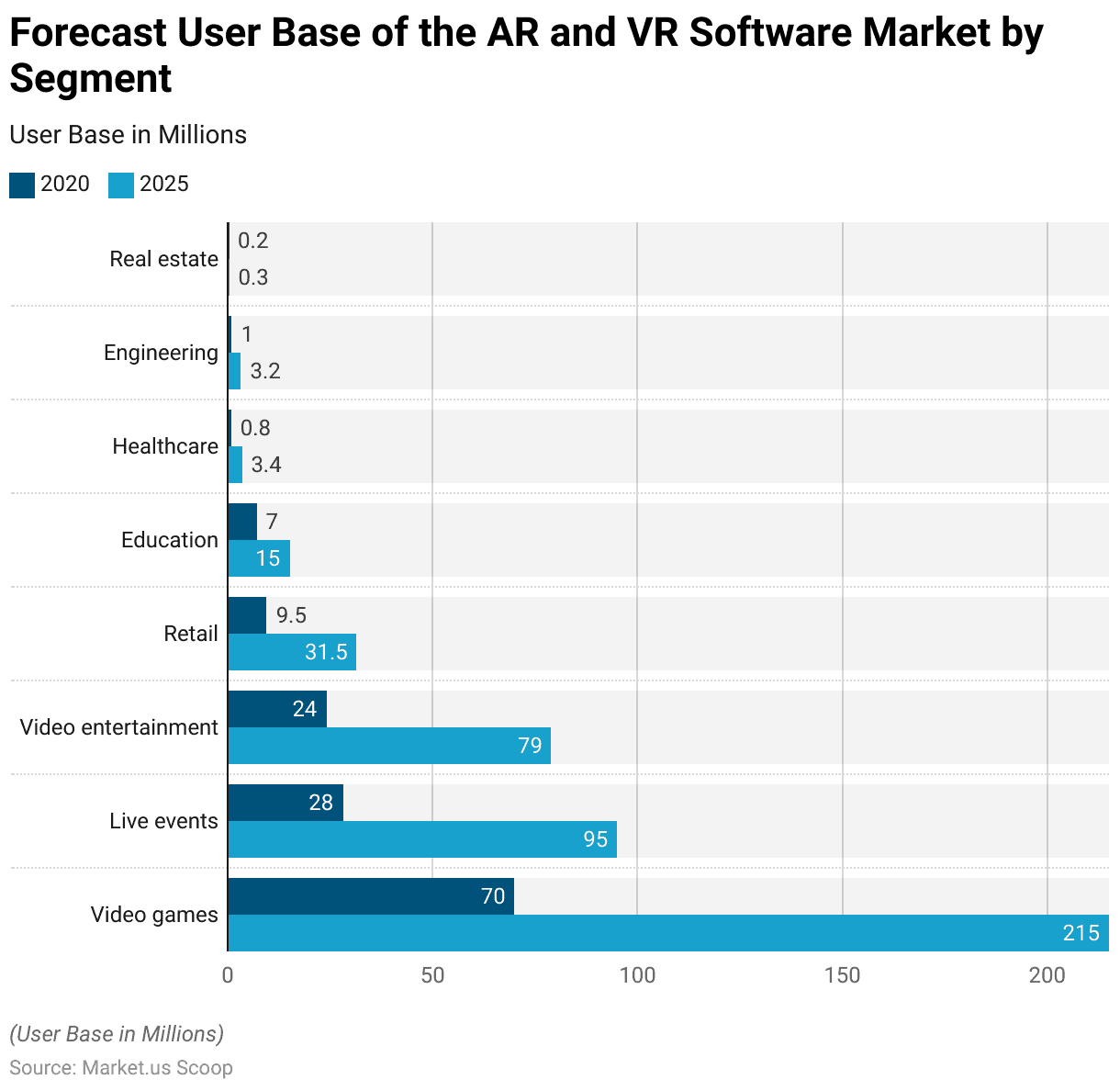
Interest in Virtual Reality (VR)
User Perception
- In the realm of virtual reality (VR), the most captivating aspect, as perceived by users, is the feeling of entering another world, with 47% of responses highlighting this immersive experience as the pinnacle of VR’s allure.
- This is followed by an appreciation for the technology itself, which garnered 36% of the feedback, underscoring the marvel at the sophisticated tech that makes such immersive experiences possible.
- Trying something completely new also stood out, with 31% of respondents excited by the novelty VR introduces.
- An intense gaming experience was significant for 26% of the participants, indicating VR’s power to transform gaming into a deeply engaging activity.
- The possibility of being ‘part of the movie’ appealed to 21%, showcasing VR’s potential to revolutionize entertainment by placing viewers inside the narrative.
- Additionally, 16% of the respondents noted new possibilities for communication, highlighting VR’s capacity to innovate interactions.
- Interestingly, 16% of individuals were unsure, indicating either a broad interest in all aspects of VR or a lack of familiarity with the technology.
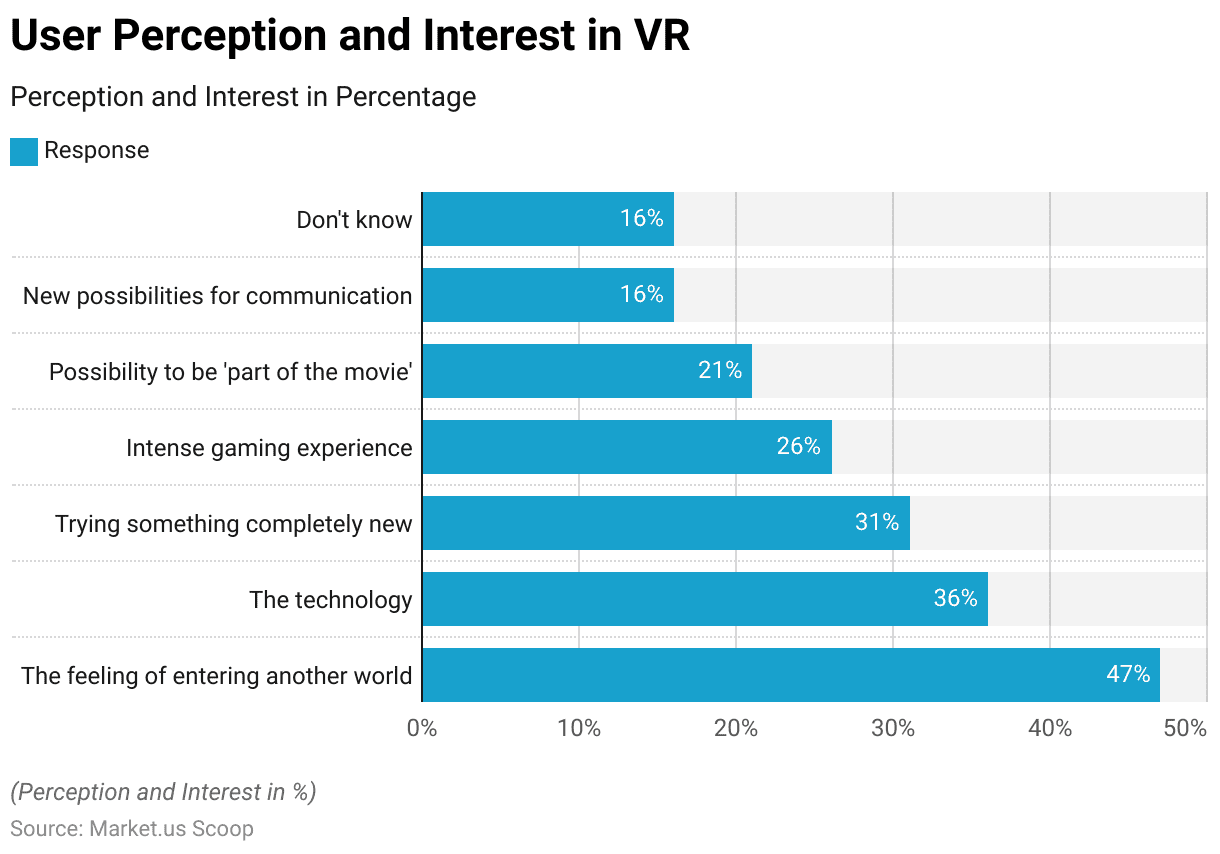
Interest in VR – By Use Case
- As of October 2022, interest in virtual reality (VR) within the United States showcased a diverse array of use cases, reflecting the technology’s broad appeal across different sectors.
- Gaming emerged as the most popular application, with 37% of respondents indicating their interest, highlighting VR’s significant impact on enhancing the gaming experience.
- Travel followed, capturing the imagination of 12% of those surveyed, suggesting a growing curiosity about exploring distant locations virtually.
- Music, watching movies and TV shows, and immersive environments each drew the attention of 9% of respondents, indicating a keen interest in using VR for entertainment beyond traditional gaming.
- Training and education, along with imaginary environments, both garnered 8% of the interest, pointing towards VR’s potential in educational settings and creative exploration.
- History was of interest to 7% of respondents, suggesting a niche yet noteworthy desire to use VR for educational enrichment and exploring past events in an immersive manner.
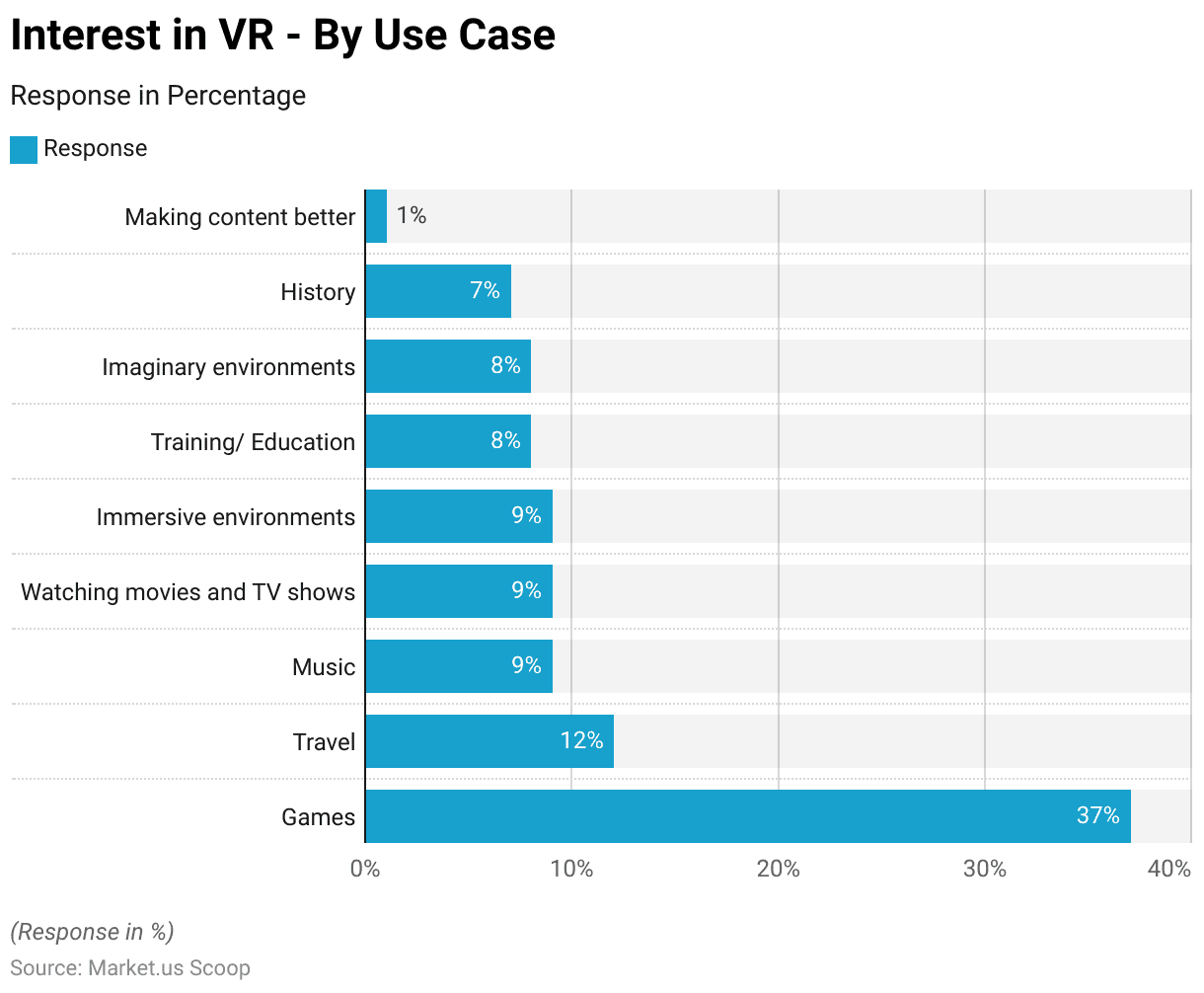
Investment and Spending in AR and VR
- The consumer segment leads the investment, with spending reaching USD 6.36 billion, underscoring the significant interest in AR and VR for personal entertainment, gaming, and shopping experiences.
- The distribution and services sector follows with an investment of USD 1.9 billion, indicating the importance of AR and VR in enhancing customer service, logistics, and retail experiences.
- Manufacturing and resources are not far behind, with spending of USD 1.66 billion showcasing the adoption of these technologies for training, design, and operational efficiencies.
- The public sector also recognizes the value of AR and VR, investing USD 1.52 billion in applications such as education, training, and healthcare.
- Infrastructure investments stand at USD 0.38 billion, pointing to the nascent but growing interest in AR and VR for construction, utilities, and urban planning.
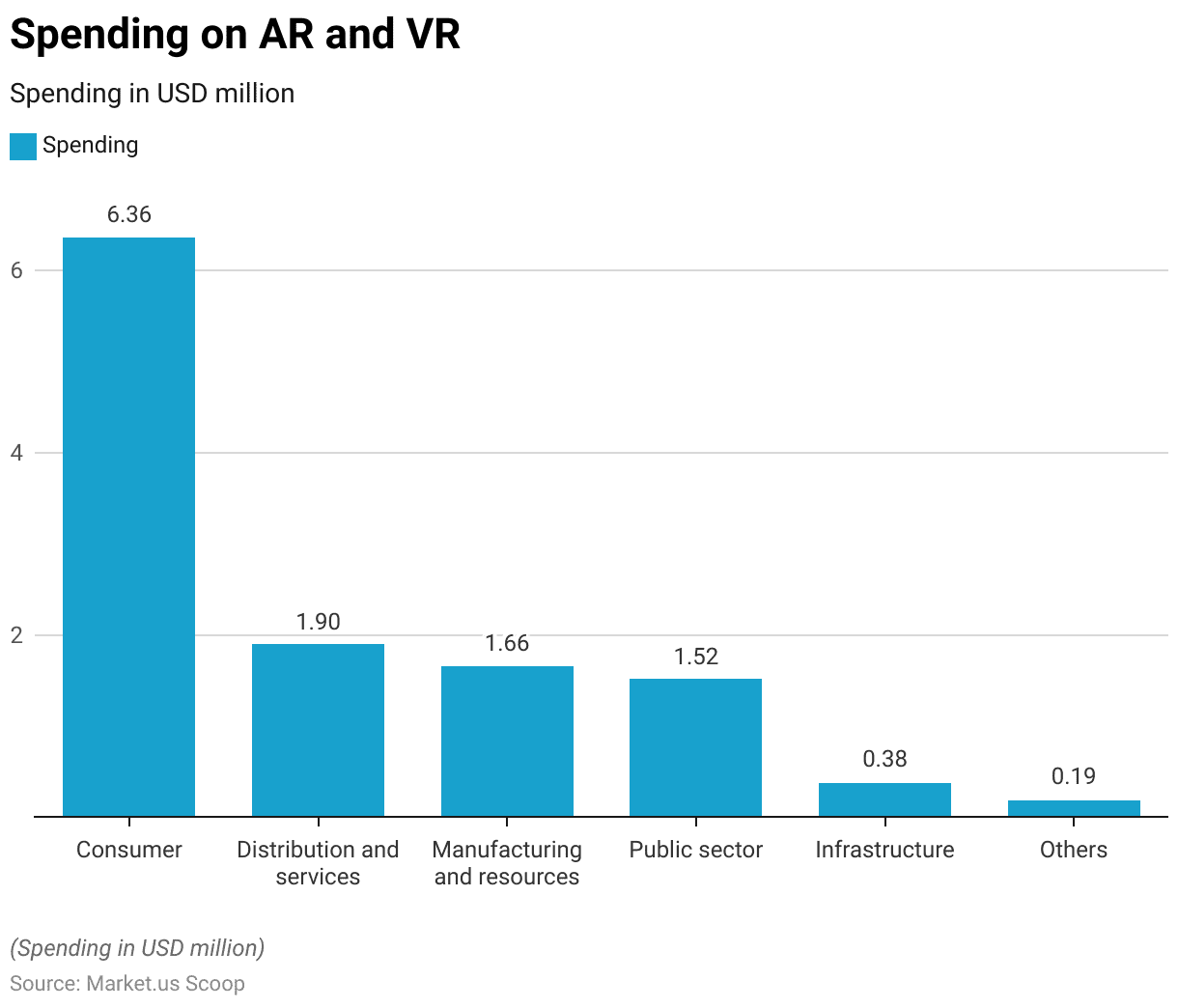
Challenges to the Adoption of AR and VR
- User experiences, highlighted by issues such as bulky hardware and technical glitches, are a major concern, affecting AR and VR at rates of 32% and 19%, respectively. This indicates a greater perceived barrier in AR related to hardware and usability.
- Content offerings present another substantial hurdle, with VR facing a higher challenge (27%) compared to AR (18%), pointing towards a demand for higher quality and more varied VR content.
- Consumer and business reluctance to embrace these technologies is equally noteworthy, cited by 15% for AR and 19% for VR, suggesting a shared apprehension toward adopting these novel technologies.
- Regulation and legal risks also pose barriers, though more so for AR (14%) than VR (12%), highlighting the potential legal complexities associated with augmented environments.
- Financing and investment concerns are raised, with AR (11%) facing slightly more challenges than VR (9%), indicating differing levels of investment confidence.
- The cost to consumers is more pronounced in VR (11%) compared to AR (7%), suggesting that the price of VR devices and experiences is a more significant barrier.
- Lastly, government oversight is considered the least barrier, affecting AR and VR at 4% and 3%, respectively, implying minimal concern over regulatory intervention.

Discuss your needs with our analyst
Please share your requirements with more details so our analyst can check if they can solve your problem(s)



